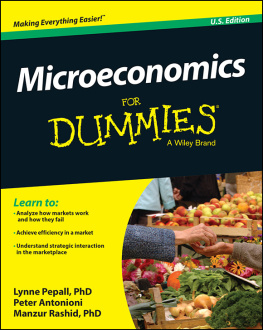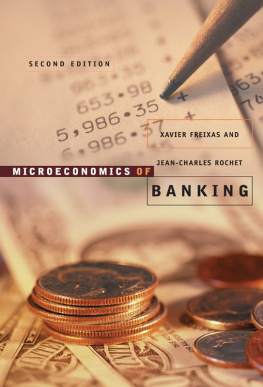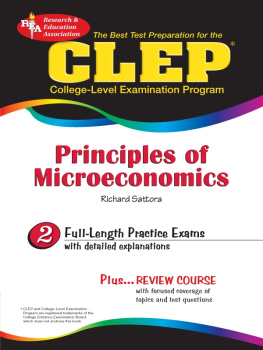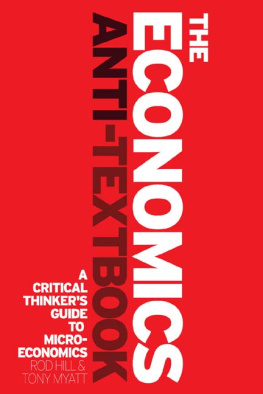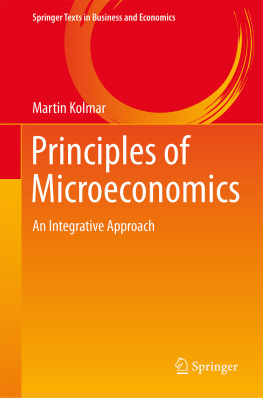Microeconomics
Microeconomics is concerned with the production, consumption and distribution of goods by the micro units of individuals, firms and markets within the economy. It can also be considered a study of scarcity and the choices to be made for the attainment of goals within constraints. These goals are those set by consumers, producers and policy makers in the market.
This book provides a brand new approach to the teaching and study of microeconomics an elementary guide to the fundamental principles of the subject. It gives students from all parts of the world the opportunity to understand and appreciate the value of microeconomic tools and concepts for analysing market processes in their economic environment, as well as maintaining a perspective on issues of trade and competitiveness, thus drawing attention to the relevance of microeconomic theory beyond the domestic scene to issues of trade and competitiveness on the international arena.
The book contains a wealth of international application insights and covers topics such as:
elasticity
CobbDouglas production functions
dynamic stability of market equilibrium
monopolies and monopolistic competition
project analysis.
The perfect introduction to the building blocks of contemporary microeconomic theory, this book will be of interest to undergraduate students in international economics, industrial economics, managerial economics and agricultural economics. It will also be a useful reference guide for graduates requiring a break down of difficult microeconomic principles.
Judy Whitehead is Senior Lecturer in Economics at the University of the West Indies, Cave Hill, Barbados.
Microeconomics
A global text
Judy A. Whitehead
First published 2010
by Routledge
Published 2014
by Routledge
2 Park Square, Milton Park, Abingdon, Oxon, OX14 4RN
Simultaneously published in the USA and canada
by Routledge
711 Third Avenue, New York, NY 10017 USA
Routledge is an imprint of the Taylor & Francis Group, an informa business
2010 Judy A. Whitehead
Typeset in Times New Roman by Keyword Group Ltd.
All rights reserved. No part of this book may be reprinted or reproduced or utilized in any form or by any electronic, mechanical, or other means, now known or hereafter invented, including photocopying and recording, or in any information storage or retrieval system, without permission in writing from the publishers.
British Library Cataloguing in Publication Data
A catalogue record for this book is available from the British Library
Library of Congress Cataloging in Publication Data
Whitehead, Judy A.
Microeconomics: a global text/Judy Whitehead.
p. cm.
includes bibliographical references and index
1. Microeconomics.
I. Title.
HB172.W45 2009
338.5dc22 2009010868
ISBN 13: 978-0-415-45452-0 (hbk)
ISBN 13: 978-0-415-45453-7 (pbk)
ISBN 13: 978-0-203-87061-7 (ebk)
Contents
The writing of this book was motivated primarily by the clamour for such a text from my students, to whom I have listened over the many years of teaching the course of Microeconomics at university level. The prevailing sentiment expressed was that, while the course seemed to come alive and have clarity and relevance in the classroom, a text book was needed that would treat the subject in a similar way. Moreover, in my interactions with students and colleagues from other institutions in North America, Europe and elsewhere, the recurring opinion was the Microeconomics course is difficult to understand, abstract and, in many cases, not relevant to the situations with which they are familiar. This book is intended to fill the void with its triad of objectives, namely: to improve understanding, reduce abstraction and increase global relevance of the subject.
According to the students, the perception of difficulty derives from the way in which mathematics is incorporated (or not incorporated) within the subject matter. They see two extremes: in one case the mathematics is so reduced, the resulting outcomes seem unintelligible (what exactly is MC = MR anyway?); in the opposite case, the mathematics seems to be for the specialized mathematician and appears to be on a track separate from the economics. This book takes a middle road, where mathematics is incorporated in a simplified and consistent way, to encourage the students to see mathematics as a language that lends greater precision and concision to microeconomics. Mathematics must be seen to elucidate rather than to obfuscate. Derivations are handled in a pedestrian way with explanations embedded in order to ensure that students can understand why and how the resulting conclusions are reached even without advanced knowledge of calculus and trigonometry.
The perception of microeconomics as abstract is said to derive from the way in which the concepts, tools and the theories appear to be taught as ends in themselves. Astonishingly, some teaching colleagues also share this view of the subject they teach. One lecturer in microeconomics spoke of the difficulty in getting across abstract concepts that led nowhere (you teach the concept of elasticity and then, what?). The approach is to remove the abstraction by showing that these concepts have highly important practical applications such as the significance of price elasticity of demand for the way in which price changes affect the total revenue of the seller (any seller, anywhere!) and its relationship to the mark-up suppliers apply to cost.
In order to enhance the perception of relevance of the subject matter of microeconomics, the applications are made in a generic way. Some students erroneously conclude that microeconomics is only for the large corporations. By presenting the material with broad statements on applicability, the aim is to dispel this myth. Certain topics such as X-efficiency, Linear and Dynamic Programming and Project Analysis (investment criteria) are included because of their practical usefulness within a wide range of economic spheres. Moreover, the book seeks to enhance the relevance of the subject by maintaining a perspective on the use of microeconomics within a macro policy framework by casting certain microeconomic outcomes in the light of trade and competitiveness policy and that of general economic growth and development. This is seen in topics such as the CobbDouglas production function, income elasticities and in the tools of general equilibrium analysis.
The book is intended primarily as a text for university students in the second or third year of their undergraduate studies in economics. The material covers the typical intermediate course, which is normally compulsory for students of economics, and related areas such a business and management studies. The comprehensive yet in-depth nature of the material and the generic, global context within which it is cast renders the book suitable for students across a wide range of economic environments.
This book has benefited directly and indirectly from the comments and or actions of many who have come into contact with the material at various stages of completion. The comments and queries from students who had access to earlier drafts allowed timely changes and corrections to be made. The requests for some of the material by colleagues and others teaching similar courses and from others using the material despite the availability of other texts, showed that the book fills a void and provided the encouragement that was needed as an impetus to complete the writing of the text. Special thanks are due to Kerry-Ann Alleyne, who served briefly as a Research Assistant and undertook the initially daunting task of converting all the illustrations into a graphics format with which we were totally unfamiliar. Along with Kerry-Ann, thanks must also be extended to Crystol Thomas and Annette Greene, who assisted with the arduous task of reading portions of the final versions to check for errors. I, however, take full responsibility for any remaining errors or omissions. Finally, I must give special thanks to my husband and sons for stoically enduring the neglect and for their support as I toiled through the night to meet deadlines. Special thanks to my younger son Jean-Paul, who so nobly granted me unlimited access to his computer when I had the dubious distinction of having three computers (including my laptop) crash fatally within the space of two weeks.


